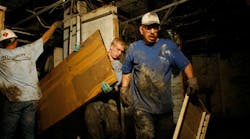10 Things That Any Emergency Preparedness/Business Continuity Plan Should Have
The International Facility Management Association (IFMA) and RLE Technologies recently released a report on facility management perspectives on emergency preparedness and business continuity in North America.
The report, “High Stakes Business: People, Property and Services,” which draws on data gathered at multiple IFMA Emergency Planning and Business Continuity research forums and the IFMA 2014 Business Continuity Survey, makes a strong business case for the importance of practicing emergency preparedness/business continuity planning, and then provides a step-by-step guide to do so effectively.
“When people think of business emergency preparedness plans, they tend to imagine massive newsworthy catastrophes like hurricanes, floods, earthquakes, tornadoes, bombings and shootings,” said Tony Keane, president and CEO of IFMA. “These events are certainly significant in their scope, but for most organizations the bulk of business interruption risk actually comes from more mundane threats like a leaking or bursting pipe, an internet access outage, or a power outage caused by an external event. The difference between bouncing back with minimal disruption or costly, long-term damage is often the plan that was in place long before the disaster occurred.”
The full IFMA/RLE Technologies report found that nearly one in five (19 percent) surveyed organizations did not have an up-to-date emergency preparedness/business continuity plan. This figure is only more shocking considering the catastrophically high cost that an unforeseen emergency can incur – including the possibility of total business failure. The study suggests that the 81 percent of organizations with an up-to-date plan are “not only able to handle identified risks, but they are also more resilient when recovering from unplanned events.”
“Emergency preparedness and business continuity is an organization’s lifeline,” said Mark Sekula, IFMA Fellow, CFM, FMP, LEED AP and president of Facility Futures Inc. “Without it, a successful company can collapse in a heartbeat.” Sekula moderated the 2014 Research Forum on Emergency Planning and Business Continuity.
“Far too many organizational leaders think it will never happen to them. They are wrong.” ~ Nick Bettis, director of marketing for RLE Technologies
The study makes a compelling case for elevating the role of facility management professional as a strategic partner as organizations and facilities gain complexity. For businesses developing or updating their emergency preparedness/business continuity plans, there are 10 areas that must be considered. An FM professional plays a significant role throughout this process.
Define roles – Determine who is responsible for the formation and execution of the plan. This is often a role assumed by a facility management professional and/or a facility management team.
Define mission-critical functions – Prioritize functions so you can determine which to dedicate resources to protecting and which to address first in the case of a failure.
Define risks – Assess vulnerabilities, especially to mission-critical functions, and determine their likelihood.
Calculate costs – Estimate the cost of down-time as well as the cost of preparation and planning.
Monitor – Utilize manpower and technology to catch disasters before they occur.
Communicate – Make sure your post-emergency communications plan is resilient.
Test – Ensure the elements of your plan are in good working order.
Practice – When possible, conduct live drills and tabletop exercises.
Adapt and adjust – A plan should be an organic thing, not something you write and file. Make regular adjustments based on testing, practice and changing situations and priorities.
Crowd source – Develop a network of strategic partners and facility management professionals that you can go to for advice when disaster strikes.
“Every organization from 10 to 10,000 or more employees needs to consider what can and will happen when threats to up-time arise,” said Nick Bettis, director of marketing for RLE Technologies. “Far too many organizational leaders think it will never happen to them. They are wrong.”

